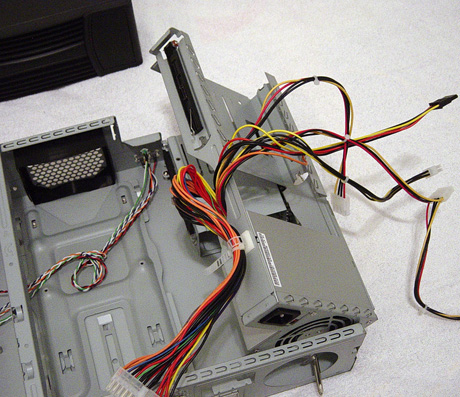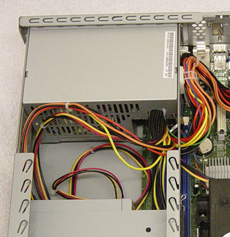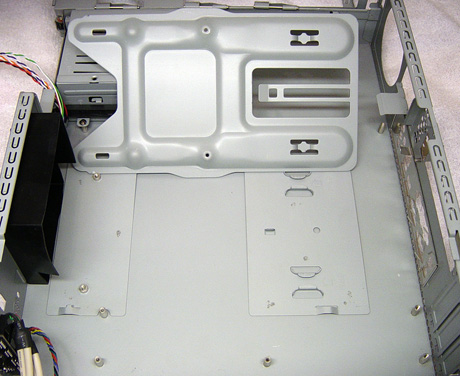Intel's Long Awaited BTX Form Factor
by Purav Sanghani on November 15, 2004 5:31 AM EST- Posted in
- Cases/Cooling/PSUs
First Look: AOpen B300 BTX case
External DesignAt first glance AOpen's B300 chassis included with Intel's evaluation kit seems like a normal half height ATX desktop case. The only thing that sets the B300 apart from ATX form factor cases of this size is the placement of the drive bays on the left side instead of the right. Still, at first glance it will seem like it's only a minor design change. We also notice there is a large section of the bezel which looks to be designed as a ventilation of some sort for an 80mm or even a 90mm fan mounted on the inside as an intake.

Click to Enlarge
At the far right of the bezel is a small door which opens to the right to expose four USB ports, audio ports, and a FireWire port.

Click to Enlarge
To remove the cover we need to remove three screws at the back of the case. We then slide the cover foreward about an inch and lift to remove it.

Click to Enlarge
Internal Design
Inside we see the drive bays at the front of the case on the left side. There is a single 5-1/4" drive bay which makes use of "optical fixing bars" to secure optical drives in place. Beneath the 5-1/4" bay is space for two 3-1/2" HDDs also utilizing the same fixing bars to secure them in place. Though AOpen implements these screw-less devices here, many screws are still used elsewhere throughout the case. Ironic, isn't it?

Click to Enlarge
To get to the 3-1/2" drive bays AOpen has designed the case in a way that this entire right section, which includes the drive bays and power supply, can be unfolded from the rest of the case out to the right. This feature helps reduce clutter when installed the motherboard as well as drives into their bays. To unfold this section there are 3 screws that need to be removed, 1 at the front and 2 at the back below the power supply. We then pull the frame forward and turn it out to the left.

Click to Enlarge
Directly behind the drive bays and mounted to the fold out frame is the FSP 275W SFF power supply with an 80mm fan. The clearance between the drive bays and the power supply is only a few inches which worried us a great deal. HDDs come in SATA interfaces but most all optical drives have an IDE interface right now. Combined with the power supply's cabling, things will definitely become claustrophobic.
 Click to Enlarge |
 Click to Enlarge |
The entire section to the right of the fold out tray will be taken up by the BTX motherboard. We noticed a metal plate on the motherboard tray called the Support Retention Module which can be removed.

Click to Enlarge
According to Intel this plate will provide extra support for the motherboard and retention for the thermal module due to the weight of the heatsink. The motherboard tray itself is made up of this entire section. Again AOpen has simplified things by using stand-offs for the outer edges of the motherboard while supporting the middle sections of the D915GMH with the retention module.










77 Comments
View All Comments
stephenbrooks - Monday, November 15, 2004 - link
Do you think if you connect the power to the fans the other way around you can get air to flow in from the front and come out of the back instead?SolarWind - Monday, November 15, 2004 - link
Actually, I like how they moved the processor towards the front of the case. This way the processor isn't in the path of hot air rising from the video card.Also, having the video card flipped over means that high performance heat sinks on the video card won't block a PCI/PCI Express slot.
DeeTees - Monday, November 15, 2004 - link
Your right, I would have sworn that I saw that mess inside of a Packard-Bell. At least they have not yet started using custom fasteners that you need a special tool to replace or upgrade components. (?)quanta - Monday, November 15, 2004 - link
BTX may deliver overall cooler temperature per volume of space, but what about all the hot air that was used to cool the CPU? Wouldn't the hot exhaust cook the video card and bridge controller, limiting overclocking potentials? Temperature aside, having air intake in front of the case reduces usable drive spaces that would be used for fan controllers. If I were designing BTX, I would put CPU on top corner, and a curved 'casing' that would route exhaust to top blowhole.PuravSanghani - Monday, November 15, 2004 - link
#42: Actually it us just these micrBTX cases that do not have rear exhausts...so far. We may see case manufacturers employing case fans as soon as BTX becomes a mainstream form factor.At Computex this past year, we did see some companies like Enlight (http://www.anandtech.com/casecooling/showdoc.aspx?... show off some mid tower cases which did have room to add extra case fans. We still have a lot to look forward to concerning the new form factor.
skunkbuster - Monday, November 15, 2004 - link
it would have been nice to have a rear exhaust...bob661 - Monday, November 15, 2004 - link
Man those P4's sure do run hot. 63C WITH the BTX case. My A64 runs at 36C inside the ancient ATX case. I'm still running the OEM CPU cooler and oh about 6 case fans. :-)Cygni - Monday, November 15, 2004 - link
Looks like BTX is going to work out for Dell and HP... but I dont think its going to have much effect for the enthusiast and self built markets. Seems to me that its going to be at its best in mBTX situations, but full BTX seems ho-hum. I guess its just more crap i gotta buy next time i upgrade. BTX mobo, BTX case, DDR2, SATA HD, PCI-Ex video card, new CPU... they really havent left anything for me to KEEP during a P4 to P4 upgrade. Me no likey.vedin - Monday, November 15, 2004 - link
Where am I supposed to put a window and neon light in that case? Hmm?Spinne - Monday, November 15, 2004 - link
I don't see what the problem is with BTX cases. The design layout, atleast for Intel processors makes a lot of sense as far as thermal regulation goes. Channeled airflow on ATX cases is a niche market, and the fact that there are no standards means that you can't be assured of compatibilty across motherboard solutions. You really don't want to have spent money on a new mobo and case only to find that a lousy capacitor prevents you from using channeled airflow. Also, there's no reason why a manufacturer can't place additional fans in a BTX case to cool the case further. Remember, cases are not upgraded as regularly as the actual hardware, so one always has the option of moving to BTX at one's lesuire. I dunno about you guys, but I live in a college dorm, and the smaller my case footprint is, the happier I am, especially if it's a full form-factor case.